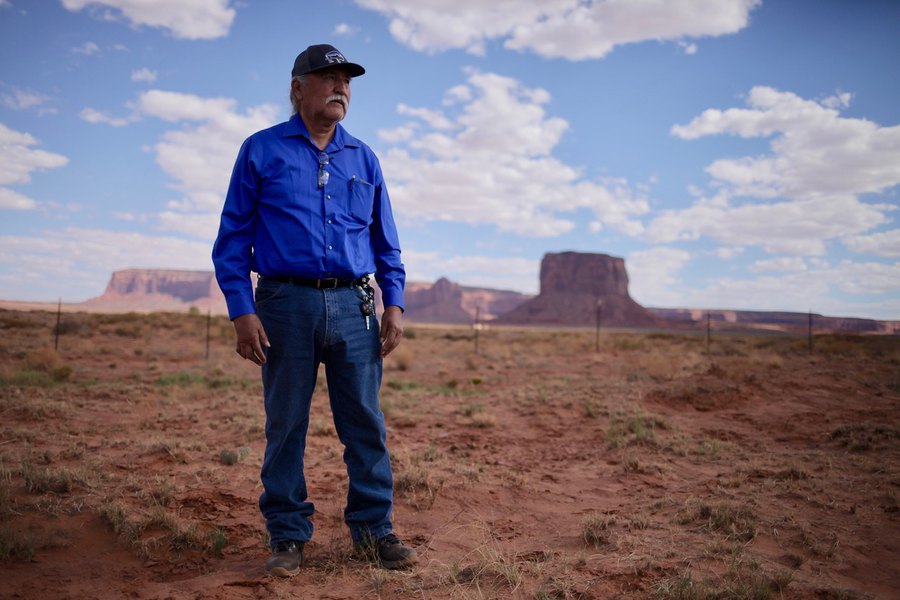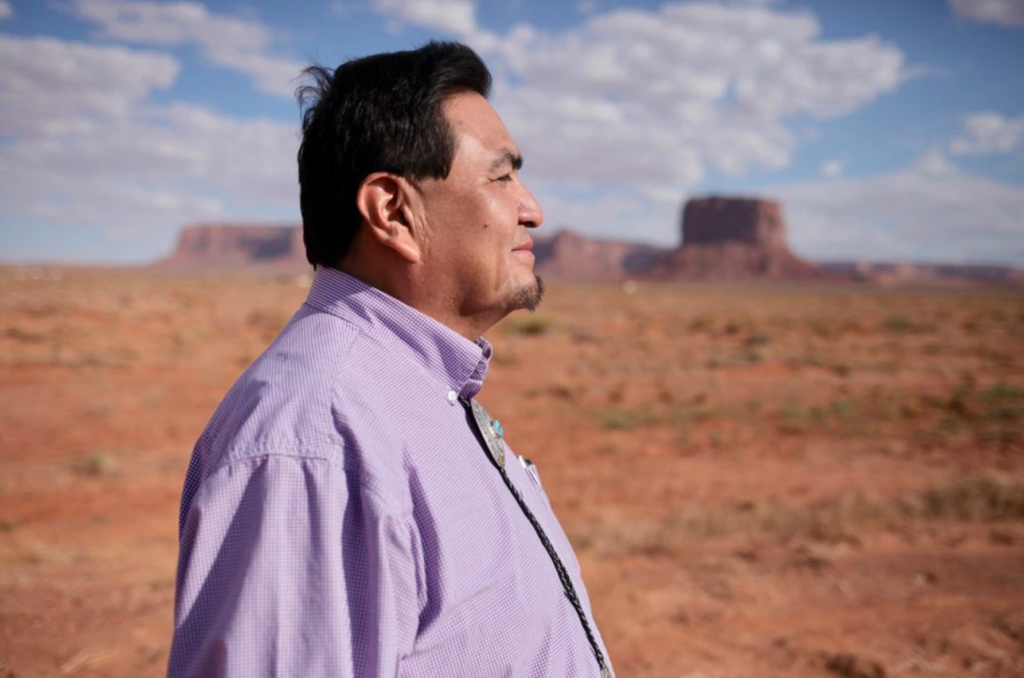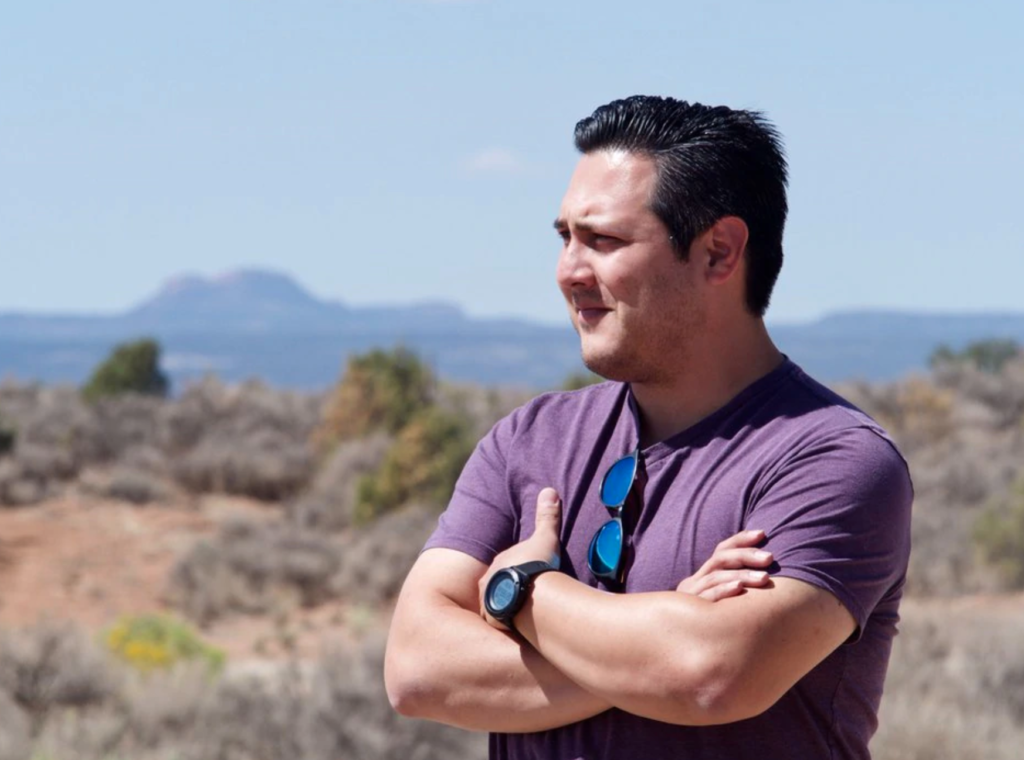‘People are energized’: Utah’s Navajo set to undo legacy of gerrymandering

Read the original in the Salt Lake Tribune.
The community gathering took place in the northern reaches of the Navajo Nation. Hundreds of people lined up in view of Monument Valley’s towering red mesas to enjoy traditional singing and dancing but also to register to vote — and end the legacy of racial gerrymandering that, for decades, has blocked Native Americans from power in this isolated corner of the American West.
Here in southern Utah’s redrock country, as in other rural reaches of the U.S., Democrats are working hard to make the so-called blue wave a reality. But the history of disenfranchisement has cast a long shadow over the Navajo Nation, one they hope they can throw off in the election.
Today, American Indians, who lean heavily Democratic, make up a slight majority in San Juan County, which encompasses this part of Utah. But for decades they were “packed” by Republican officials into a single district in the county’s southernmost reaches, echoing other partisan gerrymandering efforts across the U.S.
In 2016, a federal judge ruled that San Juan County had violated the Voting Rights Act of 1965 by illegally drawing contorted voting districts to disenfranchise American Indian voters. In a follow-up ruling last December, the judge handed down newly drawn district maps that give Navajos a majority by population in two of the county’s three commission districts. If Navajo candidates win next week, it could reshape the region.

James Adakai, a Navajo tribe member and Democratic party chairman of San Juan County, sat at a desk inside the Navajo Welcome Center in Oljato, Utah, in mid-September, sipping from a bottle of Gatorade as the powwow and voter registration drive took place outside. He was losing his voice. For weeks, Adakai had been on a frenetic circuit, working with tribal officials and volunteers from the Rural Utah Project, a not-for-profit, nonpartisan voter registration group, to get residents scattered across the 27,000-square-mile expanse of the Navajo Nation on the voting rolls. “I’m tired, but people are energized,” Adakai said.
Since last October, more than 1,600 voters — many of whom live in remote corners of the Navajo Nation and don’t have formal street addresses — have been registered, according to the Rural Utah Project.
The inequitable drawing of voting districts has meant that Navajos have never held a majority on the school board or County Commission. (In fact, the first Navajo county commissioner, Mark Maryboy, was only elected in 1986, nearly 30 years after American Indians were granted the right to vote.) As a result, some Navajos say they have seen funding for classrooms, roads and infrastructure pass them by.

In the Navajo community of Westwater — just minutes outside the tidy downtown and neatly clipped lawns of the majority-white town of Blanding — residents lack running water and electricity. “There are no sidewalks, no streetlights,” said James Courage Singer, a Democrat running for Utah’s 3rd Congressional District. “This, right here, is the legacy of gerrymandering.”
The midterm ballot in San Juan County includes two Navajo candidates for county commissioner and Singer, who is the first Navajo — and probably the first indigenous candidate — in Utah to run for a seat in the U.S. House of Representatives. The election is also seen as a referendum on the Trump administration, which has attacked tribal sovereignty on various fronts.
The Navajo, like tribes across the country, have bristled at Trump’s suggestion that tribes should be reclassified as races rather than separate governments, a legal shift that would mean that tribal members were no longer exempt from Medicaid work requirements. Trump’s downsizing of Bears Ears National Monument, which was done at the urging of Utah Republicans, has also been a key rallying point for Native Americans.
‘They don’t want us to tell our story’
“There has been a deliberate effort in San Juan County to make it hard for Native Americans to cast a ballot,” said Leonard Gorman, executive director of the Navajo Nation Human Rights Commission.
Gorman points to 1957, the year the state constitution was amended and Utah became one of the last states to give Native Americans the right to vote. Ever since, he says, white GOP leaders — many of whom trace their ancestry to Mormon settlers who moved into the region in the 1860s, after the Navajo were forcibly removed by the U.S. government — have used a host of tactics to suppress the Navajo vote.
The 2016 redistricting order was followed by a legal settlement requiring mail-in ballots to be distributed in the Navajo language as well as in English. The settlement also requires San Juan County to open three satellite polling places, each staffed with a Navajo translator.
In response to these legal victories, there has been a concerted pushback from entrenched Republican interests. Phil Lyman, a powerful county commissioner running for a seat in the state Legislature, told one reporter that he would not comply with the redistricting order and would be “happy to be held in contempt.”
Local Democrats have accused county officials of failing to observe the redrawn boundaries. During the June primary, for example, hundreds of voters received ballots with candidates from the court-invalidated districts; others received ones with the wrong party affiliation. In addition, said Adakai, hundreds of voter registration cards were reportedly “lost” by the county clerk’s office. “They’re worried that the redistricting order might shake up the balance of power,” he said. “They’re playing dirty.”
Jesse Trentadue, an attorney representing San Juan County in the redistricting case, denied Adakai’s claims. He said that local election officials were acting in good faith to implement the new voting requirements but that San Juan County’s vast size and rugged, rural character have made the effort more complicated. “The county is almost twice the size of the state of Connecticut,” said Trentadue. “But only a quarter of its residents, both Navajo and non-Navajo, have a street address.”
According to Trentadue, even in urban districts where voters have traditional street addresses it is not uncommon for 10 to 12 percent of voters to be placed in the wrong precinct. “We’re doing the best we can but mistakes happen,” he said.
Perhaps the most overt attempt to short-circuit mounting American Indian power in San Juan County came last June, when the county clerk, John David Nielson, removed the Navajo county commissioner candidate Willie Grayeyes from the primary ballot. Nielson based his decision on a complaint from Grayeyes’s Republican rival Wendy Black, who claimed that the Navajo candidate did not live in Utah but across the border in Arizona — a violation of state residency requirements.
Those assertions were later found to be false by a federal judge and Grayeyes was returned to the ballot. Nielson, who may face an investigation for allegedly falsifying documents to remove Grayeyes from the ballot, declined to comment.
Grayeyes lives at the foot of Navajo Mountain, in an isolated community called Paiute Mesa, which, like Westwater and dozens of communities across the Navajo Nation, lacks running water and electricity.
Because of the district realignment, another Navajo Democrat is running unopposed for one of San Juan County’s three county commissioner positions. A Grayeyes victory would therefore mean that Navajos would go from decades of nominal representation on the County Commission to a majority. That, Grayeyes said, would mean more resources could be marshaled to fix the rutted roads, crumbling water systems and aging schools in Navajo communities. It would also mean a reversal of the County Commission’s presently vehement anti-monument stance.
But Grayeyes knows that, even if he wins, change will not come easily. “We’ve got Republican politicians all the way up the line who are invested in deceiving the public about what the monument is and what it stands for,” he said. “They don’t want us to have power. They don’t want us to tell our story. We have a mountain to climb.”
This article was originally published as part of This Land is Your Land, a Guardian U.S. special series on America’s public lands.